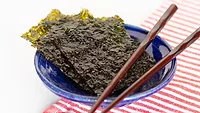As Edible Seaweed Industry Grows, Food Safety Regulation is Necessary

In an interview with Maine Public Radio, researchers from the University of New England (UNE) discussed their recent study of the food safety of seaweed, as well as the regulatory challenges associated with the emerging food. Professors Carrie Byron, Ph.D., and Kristin Burkholder, Ph.D., along with graduate student Jessica Vorse, have been studying controls for pathogens found on seaweed for the past two years. While the researchers’ findings can help inform the U.S. Food and Drug Administration’s (FDA’s) and industry’s decisions regarding seaweed food safety, there is currently a lack of regulation of seaweed as a food product.
After work by Vorse revealed the presence of low-level pathogens on seaweed harvested for food, the UNE research team was prompted to study which practices are most effective for controlling microbiological contaminants on the marine crop. Although Vorce’s original findings were not cause for concern, Dr. Burkholder expressed that, as the food-grade seaweed industry grows, it is important to keep the crop’s food safety risk low by intentionally managing the way it is handled, stored, and processed.
The researchers sourced rockweed and kelp from Maine, which they subsequently adulterated with high pathogen loads. The researchers then consulted with industry to determine which control methods were best to study so that the findings would be relevant. After testing several control methods on the contaminated seaweed, the research team found that air drying and freeze drying can significantly reduce the presence of microbiological contaminants on seaweed. The researchers also found colder storage temperatures to be effective in reducing microbial activity on seaweed.
Despite seaweed’s rapid emergence as a food product, there is little federal regulation of seaweed food safety in the U.S. At present, seaweed is considered neither seafood nor vegetable by FDA. Instead, seaweed is regulated by the agency as a spice due to its historic use as such. However, various species of seaweed are now gaining culinary prevalence with increasing use, such as in noodles, salads, and kimchi.
In light of seaweed’s lack of specified regulatory oversight, the UNE research team hopes its findings can help develop adequate food safety regulations for the crop that will protect consumers without burdening industry. However, according to Jennifer Perry, Ph.D., a professor of food microbiology at the University of Maine, a number of factors make the task of creating comprehensive seaweed regulations challenging. First, different types of seaweed respond differently to various pathogens and control methods. The seaweed industry is also an emerging commercial food group, with each farmer harvesting, growing, and handling seaweed in unique ways. Finally, seaweed is not a high-priority food product for regulatory oversight in most of the U.S., and there are concerns that regulatory bodies will apply shellfish regulations to seaweed despite fundamental differences between the two food types.
Early seaweed practices have revolved around shellfish growing, but according to Dr. Byron, regulating seaweed as shellfish is problematic because shellfish are filter feeders, whereas seaweed is not. To test shellfish for microbiological contaminants, the water in which the shellfish grow must be tested. This protocol is not relevant for seaweed, however, as the crop itself must be tested to detect the presence of pathogens. Furthermore, waters that are considered contaminated for shellfish may not be harmful to seaweed.
The research team emphasized that edible seaweed is safe, and the work they are doing is part of an effort to maintain seaweed food safety as the industry grows. Dr. Burkholder stated that the data gathered by the study is necessary to make informed regulatory decisions for seaweed, which begins by differentiating the way seaweed and shellfish are handled. Dr. Byron also expressed concern that, with the current dearth of regulatory oversight for edible seaweed, if a food safety incident were to occur, there could be a reactionary imposition of inappropriate, crippling regulation.
Looking for quick answers on food safety topics?
Try Ask FSM, our new smart AI search tool.
Ask FSM →









